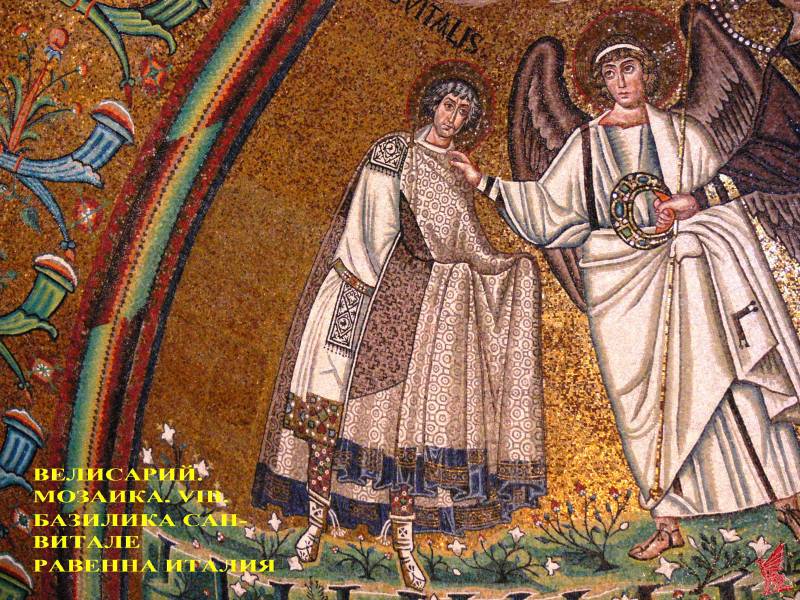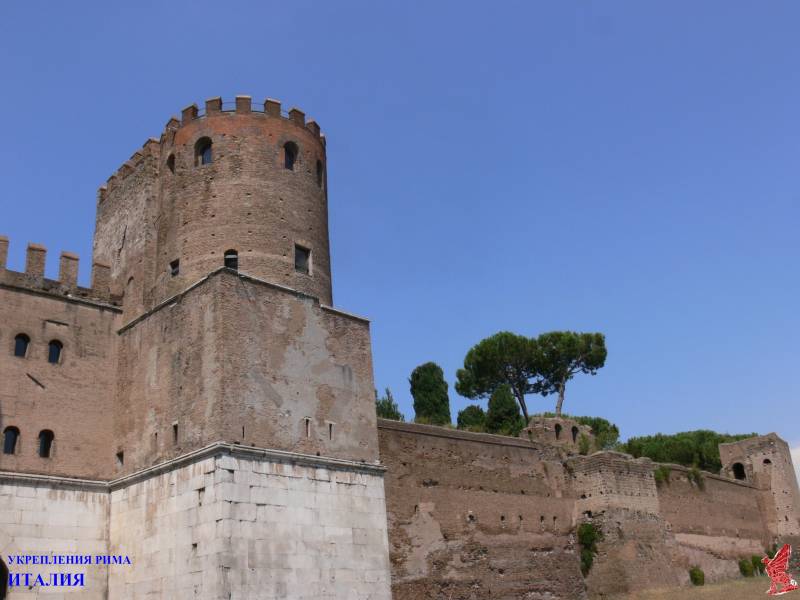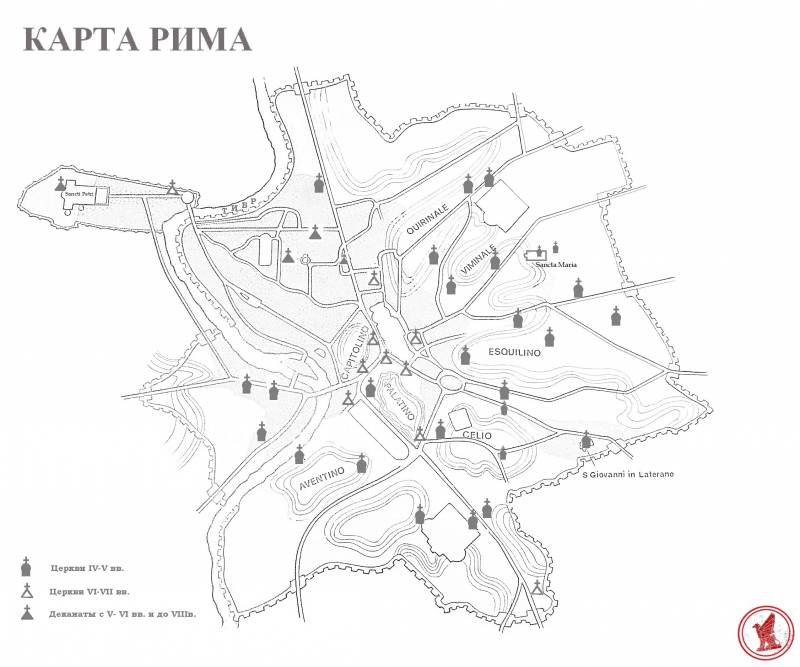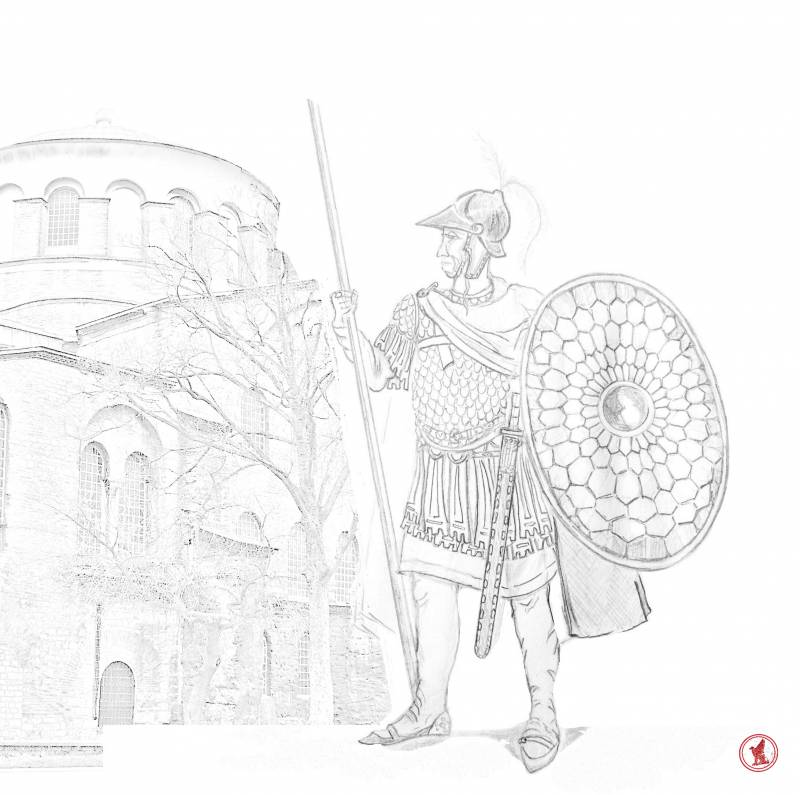Army of Byzantium VI. Battle commander Belisarius (continued)
In 535, the fighting began with the army under the command of the master of the army of Illyria Munda moving to capture Dalmatia and the city of Salona, and Belisarius and his commanders Constantine, Bes, Iber Peranius with an army of soldiers and isavrov, with allies Huns and Moors, put their ships, moved to Sicily. In Dalmatia, the Romans did not succeed.
Belisarius. Mosaic. VI century. Basilica of San Vitale. Ravenna, Italy
Meanwhile, Belisarius landed in southern Italy. The leader is ready Theodat did nothing. At the same time, in Dalmatia, the commander Konstantinian broke the ready and cleared it of them. Belisarius approached Naples and set up a camp near him: the city was taken in combat thanks to the cunning and dexterity of the Isaurians. Upon learning of this, the Goths chose the new King Vitiges, and Theodath was killed. The new king went to the port of Ravenna, the capital of Italy.
In 536, Belisarius entered the "eternal city". The Senate of Rome went over to his side.
At the same time, Vitiges concluded a military alliance with the Franks, and they decided to send the subordinate tribes to help the Goths, because before that they had formed an alliance with the empire and preferred not to take part in hostilities directly. Belisarius, realizing that the Goths had the advantage in manpower, began to prepare for a siege, strengthening the walls and bringing bread to Rome.
Battle of Rome This battle is one of the clearest examples of the military art of the Romans and the commander Belisarius, who, with limited resources, was able to withstand for a long time and, in the end, defeat a superior opponent.
Walls of rome
In the spring of 537, the city of Vitiges, gathering a huge army, moved to Rome. At the famous Mulvii Bridge, Belisarius himself led the attack against the Goths and stopped their rapid offensive. The Goths began to besiege the city, building seven camps around it. After the siege towers were built, they went on a general assault. Belisarius successfully repulsed the attackers. Hunger and deprivation of siege did not break the Romans. The active Belisarius forged the keys to the gate, fearing betrayal; residents, rescuing from hunger, sent south to Naples; even arrested and dismissed the father of Silveria, fearing his betrayal. The empire was able to send only 1600 riders to help: Huns and Slavs led by Martin and Valerian army masters. At the same time, the Goths were able to take the Port, breaking off the connection of Rome with the sea. In everyday clashes, success remained on the side of the besieged, and as often happens, the army confidently decided that it could defeat superior forces ready in open battle, forcing the commander to battle. In the course of the battle against the walls, the Romans did not succeed and again went into small mistakes. With the onset of winter 538, diseases intensified in the city, but the commander was able to ensure the delivery of bread from Calabria. Hunger and disease acted in the same way in the city and was ready in the camp, which is why Vitiges decided to go for a truce: the Goths liberated the Port, which the Romans occupied, by organizing the supply of grain. The master of the army and the consul John with the generals Bazas, Konon, Pavel and Rema arrived with an army from the empire. An attempt by the Germans to attack Rome again failed, in response, Belisarius began to seize small towns in the area of Rome. Vitiges was forced to lift the siege, which lasted one year and nine days. John captures the Samnite region.
In the fall of 537, he moved to Ravenna, leaving garrisons in cities along the way. On the heels were the warriors of Belisarius under the leadership of his spear-bearer Mundila. They rapidly captured Liguria, taking the cities of Genoa, Titsin (Padua) and Mediolan. Thus, the victory of the besieged over the superior forces of the enemy ended the battle for Rome.
In the spring of 538, Belisarius himself moved to the north of Italy. Goths surrendered garrisons. Seven thousand soldiers arrived in Italy with the treasurer Narses and his generals: the Armenians Narses and Aratius, Justin, the commander of the Illyrians, Byzand, Aluin and Fanifei, the leaders of the Erul. The commanders met and began to advance north: the fleet under the command of Ildiger went along the coast, in parallel the fleet there was a small unit led by Martin, which had an important task: to divert the attention of the enemy, depicting a huge army. Belisarius and Narses moved through the city of Urbisali (now the Mark region). The Romans saved the besieged garrison of the city of Arminius, the Goths, seeing the fleet and infantry, fled to Ravenna.
Justinian’s policy, which did not allow unity of command, with the aim of opposing “usurpation”, was extremely detrimental to the conduct of hostilities: disputes began among the commanders who, in fact, were the leader leaders. The Goths and their allies, the Burgundians, who took Mundila Mediolan (Milan) at the end of 538, took advantage of this and beat Liguria.
At the beginning of 539, Justinian was forced to recall Treasurer Narses, Heruli, soldiers from the Germanic tribe who had close contact with the Treasurer, went to him through the territory occupied by Vitiges on the terms that they would never fight the Goths. And Belisarius was losing time, besieging Auxim (now Osimo, Pizeny).
At the end of 539, a new force is entering the battle for Italy. The Franks decided to take part in the plunder of Italy. The great hordes of Theodeberg, with the support of the Allied tribes, crossed the Alps and crossed Liguria and crossed the River Po. Here they made a human sacrifice, killing the captive ready, their wives and children. After that, the Franks first attacked the camp ready, and then the Romans, defeating those and others. Upon learning of their invasion, the Roman and Martin armies fled as well. Belisarius wrote a letter to Theodeberg, in which he reproached him for his treachery. But only dysentery in the camp of the Franks was able to stop their stormy invasion of Italy: a third of their troops died, and they returned behind the Alps. Belisarius, having tried various methods of capturing Auxum and spending a lot of time on this, agreed with the garrison on his surrender. Then he hurriedly marched towards Ravenna, at the same time capturing small Gothic fortresses in the Alps. At this time, ambassadors from Constantinople Domnick and Maximin arrived in Ravenna, trying to conclude a peace treaty, on the terms of the border of the Empire and ready to pass along the Po and divide the Gothic treasures in half between Vitiges and Justinian.
At the end of 539, Mr. Belisarius, outraged by the peace negotiations, refused to sign the document, which made him suspicious. The Goths tried to win Belisarius to their side, declaring him emperor of Italy, but he refused, insisting on surrendering Ravenna. The Goths, who suffered hunger, were forced to surrender themselves and surrender their capital. So did the other garrisons in northern Italy. Justinian withdrew Belisarius to the capital, leaving Besu, John and Constantine in Italy. The Goths, seeing that the great commander with prisoners and treasures left Italy, elect a new king Ildibad, nephew of the king of the Visigoths Tevdisa. The emperor, who decided that Italy had already been subdued, was busy with a new war with the Persians, fighting the invasion of the Slavs and Huns.
In the spring of 541, the winner of the vandals and ready, Belisarius, who gathered the military council in Dar, was transferred to the east. Justinian, who suspected Belisarius of usurping aspirations, did not give him the right to fully command all the troops stationed in the area. But, it should be noted that many commanders, being in fact the leaders of their troops, did not really strive for submission, pursuing their own personal interests.
In the summer of 541, the army moved from Dara to Persia to Nisibis (Nusaybin, a city in Turkey on the border with Syria). Hired, who led the Persian army, taking advantage of the fact that the Romans settled down in two camps, attacked them: Belisarius’s camp and, who did not want to obey him, Peter’s camp. He killed many of Peter’s soldiers and captured his banner, but was recaptured by the Goths of Belisarius. Since it was obvious that it was not realistic to take Nisibis, the Romans decided to besiege the city of Sisavranon, where there were many inhabitants and a garrison consisting of 800 horsemen, at the head of which stood Vlisham. At the same time, Aref together with the shield bearers Belisarius, was sent across the Tigris River to Assyria, for its destruction, since this land was rich and had not been subjected to enemy invasions for a long time. This plan was carried out, and the city of Sisavran surrendered, since the majority of its inhabitants were Greeks.
But Belisarius did not continue the offensive actions, as his secretary Procopius writes in “The Secret stories", Personal motives (treason of the wife who was friends with the empress) forced him to throw the theater of war and thereby subject the territory to Syria to plunder by the enemy. He was recalled to the capital.
In the spring of 542, in retaliation for the invasion of Khosrow I, with the king of the Arabs, Alamunder III, he crossed the Euphrates. Since he devastated Syria the previous year, his goal was Palestine and Jerusalem. Local commanders, such as the cousin of Emperor Yust, a high school, tried to sit in the fortifications, not opposing the Shah. Again, the Emperor sent Belisarius, who arrived in the town of Europe (not far from present-day Qalat-es-Salihia, Syria), located on the Euphrates River, to rescue the Romanians. Khosrov sends ambassadors to him for the purpose of intelligence of the Roman troops. Since the forces of the commander were extremely small, and his fame is known to the Persians, Belisarius prepared a "spectacle." The ambassador saw a “huge army” consisting of selected warriors: Thracians, Illyrians, Goths, Heruli, Vandals and Mavrusians. Specially before the ambassador went strong and high, engaged in daily affairs, this performance made an impression, and the Sassanians decided that Belisarius had a huge army.
The task of Belisarius was to "push out" the army of the Persians from the Romanian limits, since there was no strength for the battle. At the same time, a plague broke out in Palestine. This, as well as the "spectacle", influenced the decision of the Sassanian king. He quickly brought the crossing and crossed the Euphrates: “For the Persians it is not difficult to cross any river, because when they go hiking, they take with them the iron hooks prepared in advance, which they hold together with each other long logs, immediately building a bridge in any a place where they want. "
But the suspicions of the basilus against Belisarius were not dispelled. In Byzantium, due to the absence of a mechanism for transferring supreme power, the threat of its seizure by the military, as in Rome before, was constant. Literally in 50 years, the hekatonarch (centurion) Fock would seize power from the basil warrior of Mauritius, and he himself would be overthrown by the exarch of Africa Irakli.
Describing the events related to Belisarius, Procopius believed that the emperor and his spouse very much wanted to seize the commander's wealth. It was assumed that he captured most of the treasures of the Vandals and was ready, and gave only a part to the basilica. The military leader was deprived of the position and "squads", his spearmen and shield bearers were distributed by lot. Belisarius was morally broken.
Meanwhile, in Italy, the new Gothic king Totila inflicts one defeat after another on the Roma, smashing commanders- "leaders" one by one.
In 543, Naples was commissioned. In Rome, there were unrest, throughout Italy raged plague.
Under such conditions, in 544, Belisarius returned to Ravenna with a small army. He led the army on the terms that will contain it at his own expense. But most likely he didn’t want to do this, as Procopius writes, he kept the money collected from Italy.
In 545, the city of Totila began the siege of Rome. Belisarius’s attempt to ensure the delivery of bread to Rome from Sicily failed: the head of the Roman garrison Bes did not show promptness, and the Goths seized the transports with bread. Finally, Belisarius waited for reinforcements from Constantinople with John. Again an old feud broke out between the generals. And Belisarius sends John to Constantinople. In Rome, the famine began. The commander personally commanded a breakthrough for the delivery of bread to the "eternal city", but was forced to retreat, fell seriously ill and stopped the fight.
In December, the Isaurus 546 surrendered Rome to Totil, and the Goths broke into the city: here they discovered the wealth that was earned by speculation, responsible for the defense of the city, Bes. The city was looted, the city walls, many buildings, outstanding architectural monuments that survived the previous sieges and storms of barbarians were destroyed, the Roman population and senators were captured.
Map of Rome V-VIII centuries.
Totila, leaving part of the troops to fight Belisarius, moved south against the army master, Patrik John.
In 547, the army master, John, arriving from the capital, occupied Tarent. The recovered Belisarius again entered Rome. He quickly began to build a wall around the city, but did not manage to rebuild the gate. Totila returned to Rome and went to the assault. Belisarius built his best warriors in the unfinished gates, and the city dwellers on the walls. Two assaults of Rome were repulsed.
The case of the Romanians in Italy was complicated by the fact that the problems of Italy did not interest the emperor, who was engaged in theological disputes, under these conditions, Belisarius received permission to leave the theater of operations. Justinian, despite the fact that he was the last true Roman emperor, still, like most Byzantines (the Romans), preferred quick success and profits from the enterprise, investing very little in them. Defeats and difficulties in the fight against enemies were partly associated with these particular features of the ruler of the empire. Totila, using the current situation, suffered military operations at sea, and again took Rome (again the Isaurians again betrayed him). In such circumstances, Belisarius resigned. Since then, the commander lives in the capital.
In 559, in the winter, huge hordes of Hun-Kuturgurs and Slavs invaded the ice of the Danube across the Balkans into Thrace. The Huns laid siege to the Thracian Chersonesos and approached the capital. The palace troops, little adapted to war, took over the protection of Byzantium. As Procopius wrote: “Such terrible and great dangers seemed unquestionable that lohagi, taxiarchs and many warriors were really placed on the walls, in Sikka and the so-called Golden Gates, if they attacked. In fact, however, they were incompetent and were not even sufficiently trained in military affairs, but were from those military units that were appointed to keep guards day and night, which are called scholaria. ”
A rich citizen in the form of scholaria. VI century. Reconstruction of the author
Fortunately, 54-year-old Belisarius was in the capital. He spoke out against Khan Zabregan. Having neither a numerical advantage nor a trained army, he, using military cunning, armed and equipped both decorative, by this time, scholarians, and ordinary people. The terrible name of the commander did his job, the Huns fled from the walls. Huns and Slavs could not take Chersonesos. When they left the Danube, Justinian redeemed the prisoners from them, paid a huge tribute and provided them with a ferry.
So in the slope of life, Belisarius once again served the cause of the Romans.
In conclusion, it is worth noting that he has gone from a spearman to a master or stratilate, the highest military post. Nevertheless, with all the higher military ranks of previous periods observed in the 6th century, as indeed in the 5th century, we observe that troop control in reality takes place on the basis of “leaderism”. The commander is gathering his "army" -druzhinu among those groups of the population, barbarians and warriors, where it can be done and with them acts in the campaign. Partly, the war becomes the personal enterprise of military leaders, when they at their own expense recruit troops and "earn" money from the war, sharing the loot with the supreme power. This system successfully worked throughout the reign of Justinian the Great, but began to give serious failures by the end of his reign. Because of it, the affairs of the Romans took a completely lamented turn already in the Fokey board. This continued until stabilization, thanks to the fem reform. But these events are beyond the period under consideration.
It should be noted: one should not confuse the system of formation of troops and the system of using it on the battlefield, such confusion often leads to numerous mistakes in studying the army of this period.
As for the management system, if we look from the present, then that harmony that was in Rome during the period of the republic and the early empire, we, of course, do not observe.
The problem for the Roman Empire was that all the brilliant beginnings of this period were not brought to the end. The return to the bosom of the state of Africa, Italy and even parts of Spain was not completed: the wars did not cease here. The codification of Roman law and the novels, which, according to Justinian, should be removed from the court by professional litiggers (lawyers) who turned him into a circus, failed. Comments on the Code appeared in just a few years and the lawyers continued their “circus” activities.
It is difficult to say, and even the sources that have come down to us do not allow this, but Basil Justinian was surrounded, or created an environment consisting of brilliant commanders, leaders, lawyers and geometers (builders and architects).
One of them, of course, was the hero of our small article.
But, the work that they carried out was not systemic, but project-based, since it depended heavily on the bastion that was “fascinated” by the projects, including the destructive ideological disputes about faith.
Belisarius proved himself to be an outstanding warrior during the restoration of the Roman State, who can be ranked with the best generals of the past. UN was one of the few who could "less achieve more."
Unfortunately, his experience was not taken into account in the subsequent development of the country: scholasticism, which flourished in Byzantium, captured the military sphere, and only the return of power to the warriors from the 9th century BC. contributed to changes in this area.




Information